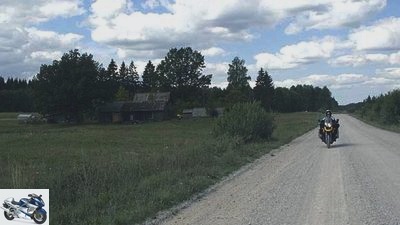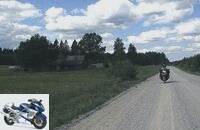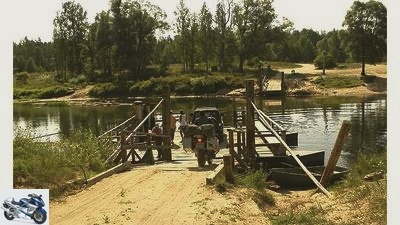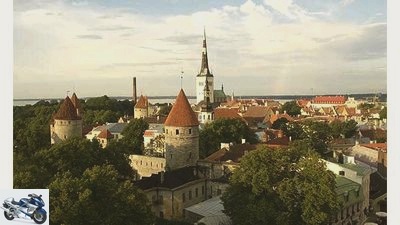Table of contents

Kirsten Fiege
to travel
MOTORCYCLE on the road: Baltic States
MOTORCYCLE on the road: Baltic States
Experience of loneliness
Hardly any curves and only one 318 meter high mountain ?? From this perspective, the Baltic region does not seem very attractive to motorcyclists. The attraction of these countries, however, lies elsewhere. Those who take their time will discover it.
Ralf Bottigheimer
01/30/2007
No, the “MS Lisco Gloria” definitely does not qualify as a cruise ship, and the Baltic Sea does not qualify as the Caribbean either. Nevertheless, there is something like a dream ship atmosphere on the sundeck of the ferry: the calm sea shines like the sky in the deepest blue, and the view of endless water – the port of Kiel has long since lagged behind the horizon, and the arrival in Lithuanian Klaipèda will not be until tomorrow expected – has something really meditative about it. Kirsten and I are happy to have chosen this form of travel to the Baltic States and not the 1000-kilometer route through Poland.
On land we immediately head north, aiming for Liepaja, which is already in Latvia, on the coastal road. From there it should go over a finely woven network of branch lines through the three Baltic countries Estonia, Latvia and Lithuania – perfect for enjoying the solitude that characterizes this region. The route in the direction of Bauska comes in handy: Small farms only appear occasionally, each with a stork’s nest on the roof. Oncoming traffic? Hardly. Other tourists? Only after a few hours’ drive when visiting Rundale Palace, a baroque masterpiece that was built in 1735. Nothing was spared in the magnificent halls and salons: everywhere gilded stucco, imposing sculptures and artistic wall and ceiling paintings.
Buy complete article

MOTORCYCLE on the road: Baltic States
Experience of loneliness
8 pages) as PDF
€ 2.00
Buy now
After the visit, we spontaneously decide to take a detour back to Lithuania – since the Baltic countries have belonged to the EU, border crossings only take a few minutes. We are drawn to the “Hill of Crosses” near the town of Šiauliai. A huge hill that consists only of crosses, rosaries and images of saints and has long been considered the most important religious pilgrimage site in the country. At the same time, it is a sign of resistance, we learn from an old woman who speaks German. The first crosses were erected as a protest against the harsh tsarist rule, and in the end this mountain continued to grow during the upheaval of the 80s and 90s. “The Moscow regime even had this hill leveled once, but the next day there were new crosses.”
Back in Latvia, we head for Ogre, where the travel guide promises a nice hotel. The last 70 kilometers, however, lead over a gravel road, which is why we arrive at our destination quite late – which then turns out to be a shabby dump. No thanks. Only in Sigulda, already in the middle of the Gauja National Park, do we find a place to stay.

Kirsten Fiege
After a while the road ends at a rustic wooden ferry.
The next day we extensively explore the dense oak forests of the extensive national park. The Gauja winds through deeply cut valleys, and now and then light sandstone cliffs line the shore. After a while the road ends at a rustic wooden ferry. The old vehicle looks almost overloaded with a car and a motorcycle. At least the old ferryman has his hands full staying on course in the current. There is an incredible calm over the whole scene, and it is not surprising that bears, wolves and elk are said to live in this area. We let ourselves drift further and further through this almost untouched landscape.
At Tsiruli we cross the border from Estonia. If the Latvian language sounded rather foreign to us, we don’t understand a word here – somehow it already reminds us a lot of Finnish. The piste meanders through the towns of Kaanu, Ruusmae and Vastsekivi towards the climax of the Baltic States – the 318 meter high Suur Munamagi, which rises like a giant from the gently undulating land. The “pass summit” is quickly climbed. Which in some respects can certainly keep up with some of its colleagues in the Alps: There is a well-frequented visitor car park with a snack bar and various souvenir shops.
A stark contrast to what then follows: In the region along the Russian border, there no longer seems to be any prospect for anyone. Many villages and farmsteads seem neglected, and the residents evidently seek refuge in alcohol in the morning. Since, to make matters worse, it is now raining heavily, we drive to the university town of Tartu in one go. A really cozy pub catches us, relieves the bitter impressions a little.
Despite relatively little sleep, we are drawn further north in the early morning. After a few kilometers, the huge Lake Peipsi appears. The villages along the road seem friendly and inviting again. Colorful wooden houses in the middle of large gardens. The residents, who are mostly of Russian descent, mainly grow onions, which they sell for sale on every corner. You live in simple circumstances, but exude great satisfaction.
Unfortunately, there is still no bathing weather, and so the nearby Russian Orthodox Kuremagi Monastery in Kuremae lures us away from the beaches of the lake. With its onion domes and jagged walls, the building, visible from afar, is reminiscent of an enchanted fairytale castle. Inside, nuns from all parts of the former USSR live, and everything they need to live comes from their own production. In order to earn some money, the nuns run a small but nice guest house. But it is still too early to move into a room for the night. Our destination for the day is Palmse Manor in Lahemaa National Park. Its baroque main house is also reminiscent of a castle, which is an excellent place to spend the night.
On small, unexpectedly winding paths, we roamed the park with the BMW the next day, which, with its extensive forests, raised bogs and picturesque coastal stretches, is considered to be the most beautiful in the country. Unfortunately, none of the numerous moose that are supposed to live there runs in front of the camera. Instead, we are all the more troubled by mosquitoes when trying to spot beavers in the thicket. After a while we give up unsuccessfully and explore each of the four headlands that protrude far into the Baltic Sea. Small fishing villages and the coast strewn with boulders make the idyll perfect, but Tallin is not far, and after days of country life we feel like a little big city.

Kirsten Fiege
Well worth a visit in itself: Estonia’s capital, Tallinn
Immediately we dive into the maze of medieval streets. The former Reval was once the eastern outpost of the mighty Hanseatic League, and most of the houses of the wealthy merchants have long been restored and glow in a wide variety of colors. Despite the hustle and bustle – Tallinn has become a popular destination for city tourists – it is a pleasure to stroll through the streets around the market square with its many pubs and restaurants. The city is booming and is obviously looking for a connection to the rest of Europe. There is also a lot of activity in the industrial areas outside the city wall: new production facilities are being built on every vacant spot. A city in which there would certainly still be a lot to see, but the curiosity about two islands attracts us.
Endless birch and pine forests, otherwise little that distracts the view while driving towards the Estonian west coast. Color only comes back into play with the colorful wooden houses from Haapsalu. In the nearby ferry port, Kirsten and I cross over to Hiiuma and reach a world that is a tad more tranquil than the rest of the Baltic States. In front of the dense forests, the moors and the already lonely sandy bays, modernity seems to have completely surrendered. As soon as the engine is off, there is absolute silence.
Two days later we roam the somewhat larger neighboring island of Saareema, which also seems to consist almost entirely of forest and meadows. We stroll calmly to the island’s capital Kuressaare below an imposing castle complex. A cafe in the nice center has chairs and tables outside in the sun. We could sit here for hours. Or on the beach to look out over the shimmering turquoise Baltic Sea. The island world gradually enchants our senses, and it is difficult to get back on the saddle. Fortunately, it was pouring down when we took a ferry from Parnu to the Baltic States two days later
Info
Lots of Baltic flair, untouched nature, attractive cities: the three Baltic states of Estonia, Latvia and Lithuania offer an exciting alternative for vacationers in the north of the country.
D arrival
If you want to travel to the Baltic States by land, you unfortunately have to accept a very long journey through Poland. It is around 1000 kilometers from the German-Polish to the Polish-Lithuanian border. Recommended (at least for North Germans) is to travel by ferry from Lubeck, Sassnitz, Kiel or
Rostock to Klaipèda, Ventspils or Riga. The simple passage from Kiel to Klaipèda, for example, costs 181 euros per person in a double cabin (low season), a motorcycle costs 15 euros. Further information and booking: Lisco Baltic Service, phone 0431/20976420; Internet: www.dfdslisco.com. If you want to go on board in Rostock, contact the ferry company Scandlines, information and booking: Telephone 0381/54350; Internet: www.scandlines.de.
D travel time
The Baltic region has a maritime-continental climate with warm and dry summers. Already in early summer (June) you can expect constant weather, which usually lasts until September. A rain suit
and a warm sweater still belongs
to the basic equipment.
D documents
Border controls are still taking place because the countries are not yet part of the Schengen Agreement. For EU citizens
the identity card is sufficient, in
Travel year (2006) the passport was recommended. Take a green insurance card with you for the vehicle.
D money
Despite EU membership, the euro has not yet been introduced in the three Baltic states, in Lithuania, Latvia and Estonia
So you still pay with the respective national currency: Litas, Lats and Krone. You can get cash by debit card at practically every corner, and credit cards
are accepted in newer hotels and larger restaurants, as well as at most petrol stations.
accommodation
In general, the Baltic countries have a good infrastructure. Hotels and cozy guesthouses can be found almost everywhere along the attractive Baltic Sea coast as well as in all larger cities. As a rule, you have to calculate between 20 and 70 euros per person per night. In the interior, however, you should look for one in good time
Looking around the room if you don’t want to spend the night in the saddle. A tent provides more “freedom” – and saves the budget: from four euros it can be on one
Related articles
-
Lorenz to travel Poland and the Baltic States Poland and the Baltic States Stars in the east Estonia, Latvia and Lithuania: Completely different in…
-
Motorcycle tour Baltic States Lithuania Latvia Estonia
Jo Deleker 17th pictures Jo Deleker 1/17 Motorcycle touring in the Middle East of Europe. Jo Deleker 2/17 Peace in its purest form. Those who want to…
-
to travel Baltic states Baltic states Different than expected Beaches like on the Mediterranean, cappuccino like in Italy and magnificent buildings that…
-
MOTORCYCLE On the Road: Tunisia
Huh to travel MOTORCYCLE On the Road: Tunisia On the way: Tunisia Wind, sand and stars Tunisia attracts with beach and sun. Those who only go on vacation…
-
Motorcycle enduro tour from Berlin to the Baltic Sea: Mark Brandenburg
Golletz to travel Motorcycle enduro tour from Berlin to the Baltic Sea: Mark Brandenburg Motorcycle enduro tour Brandenburg Enduro tour through the Mark…
-
MOTORCYCLE on the road in Morocco
Brings to travel MOTORCYCLE on the road in Morocco MOTORCYCLE on the road in Morocco North Africa’s last gap It has become tight in the northern Sahara….
-
On the road in Denmark by motorcycle
Daams 14th pictures Daams 1/14 Time for the rain suit: a short shower on the way to Tyboren. Motorcycling in Denmark between the North Sea and the Baltic…
-
MOTORCYCLE road book: Out and about on the world’s dream roads
Drawing: archive to travel MOTORCYCLE road book: Out and about on the world’s dream roads MOTORCYCLE road book On the way on the dream roads of this…
-
Wipey motorcycle helmet windshield wipers: safer on the road in the rain
Wipey 6th pictures Wipey 1/6 A Slovenian startup has developed a windshield wiper for motorcycle helmets. Wipey 2/6 The windshield wiper comes as a small…
-
Motorcycle tours – on the road in Sardinia
Deleker 18th pictures Deleker 1/18 The basalt rocks of Capo Testa. Deleker 2/18 Castelsardo looks particularly picturesque from the outside. Deleker 3/18…